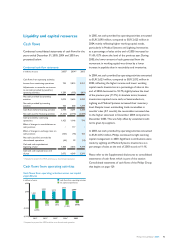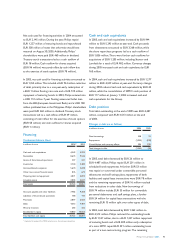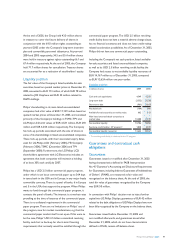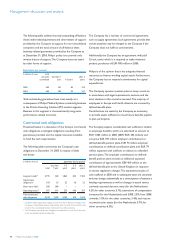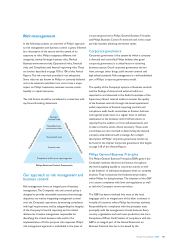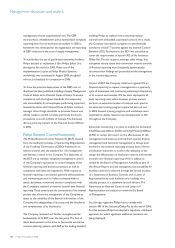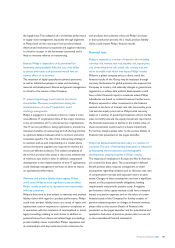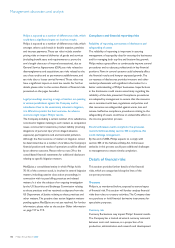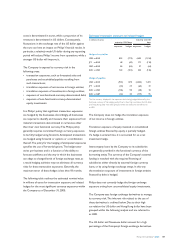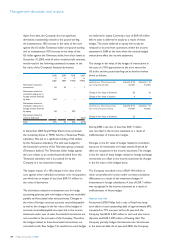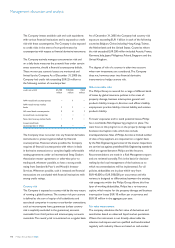Philips 2005 Annual Report Download - page 103
Download and view the complete annual report
Please find page 103 of the 2005 Philips annual report below. You can navigate through the pages in the report by either clicking on the pages listed below, or by using the keyword search tool below to find specific information within the annual report.Philips Annual Report 2005 103
Risk categories
Taking risks is an inherent part of entrepreneurial behavior.
A structured risk management process encourages
management to take risks in a controlled manner. The
Company has a structured risk management process in
place that recognizes different risk categories at strategic,
market/business environment, operational, fi nancial and
compliance level.
Within Strategic business risks Philips covers areas that
infl uence the company’s strategic opportunities and threats.
Areas such as capabilities and longer-term value creation
are covered in the form of, for example, risks related to
technological innovation, differentiation and alliances.
Philips separates strategic risks into auditable risk activities.
The Market/Business environment risks cover the effect
that changes in the market may have on Philips. Risks
related to areas such as economic and political development
and power concentration are likely to affect all market
participants in a similar manner. Philips’ center of attention
is to identify potential issues as early as possible and to
alert management through peer and industry monitoring.
Operational risks include adverse unexpected development
resulting from internal processes, people and systems, or
from external events that are linked to the actual running
of each business (examples are product creation and
supply chain management). Within the area of Financial
risks Philips indentifi es risks related to Legal, Treasury,
Pensions and Fiscal. Compliance and fi nancial reporting
risks cover unanticipated failures to enact appropriate
policies and procedures and risks that could negatively
impact Philips’ reliability of reporting, correctness of
disclosures, and safeguarding of assets.
Strategic business risks
Identifi cation of new sources of differentiation, and
identifi cation and successful integration of new acquisitions
are important to realize Philips’ profi table growth ambitions.
Some of Philips’ operational divisions face industry trends
towards diminishing opportunities to differentiate on the
basis of technical performance. These trends are fueling
the emergence of new low-cost Asian players in the market.
This development makes the identifi cation of new sources
of differentiation for these operating divisions increasingly
important. Moreover, to realize the growth ambitions
within certain operating divisions, further acquisitions will
be required. Such acquisitions could expose Philips to
integration risks.
Philips’ success is dependent on technological innovation
and its ability to secure and retain intellectual property
rights for its products.
Philips’ longer-term success depends on technological
innovation, meeting global standards and its ability to obtain
and retain licenses and other intellectual property (IP)
rights covering its products and its design and manufacturing
processes. The IP portfolio results from an extensive
patenting process that could be infl uenced by innovation,
strategic alliances, outsourced development and changes
in regulations. The value of the IP portfolio is dependent
on the successful promotion and market acceptance of
standards developed or co-developed by Philips. Philips
risks losing revenues if it is not able to generate new
licenses or to enforce its IP entitlements.
Philips faces the challenge to secure short-term
profi tability while simultaneously investing in long-term
growth strategies.
The markets in which we operate are are characterized by
increased competition from emerging players, with a
possible concentration of companies from emerging markets
and leakage of technology competencies, despite increased
activity to secure IP protection. In order to mitigate these
risks and be able to maintain short- and medium-term
profi tability, Philips needs to successfully grow in new
areas and actively participate in the innovation community
in emerging markets. A failure in one of the key drivers
could hamper the ability to attract and commit partners
in consumables. If Philips is unable to adjust competencies
and capabilities in order to pursue a more dynamic business
model, its long-term results could suffer.
Philips’ use of strategic alliances may result in confl icts
of interest, loss of control over investments and loss of
control over proprietary technologies.
Philips operates in high-tech markets with rapid
technological development, which requires the Company
to make large fi nancial investments. Philips continues to
utilize partnerships in order to share the risks associated
with large investments and to access technologies that
enable innovation, etc. These partnerships take the form
of minority shareholdings, joint ventures and majority
shareholdings. Managing the growing number of strategic
alliances, and in particular bridging the international, legal
and cultural differences, is a risk in itself. In addition, Philips
may face an increased risk related to the supply of essential
components and also confl icts of interest, loss of control
over cash fl ows and loss of proprietary technologies by
participating in ventures.


